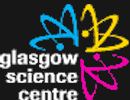Science trail - relativity.
Here's the link to the Word file, Lindsay
You are going to become science detectives and investigate what the latest science news story is all about.
![]()
You can find the story here. Have a quick glance now, just to get the flavour. You can spend more time on it back in class.
Right now you're going to follow a trail to hunt for clues to the real science behind the story.
You will work in teams to search for exhibits that have science secrets to tell you.
Try not to get lost, but don't worry if you do. Glasgow Science Centre is a big place, but friendly.
If you're not sure about something, just ask anyone in a Science Centre T-shirt. They will point you in the right direction.
Here's how it works
Two teams take part in the science trail - a control team at the computer and a field team that hunts for clues. The teams work together to solve a puzzle.
When the field team finds a clue it change places with the control team. So everyone gets several chances to be controllers at the computer and field operatives around the Science Centre.
The teams
The field team has four members. The control team can have two, three or four members.
Each member of the field team has a particular job, besides talking things over with the rest of the team and finding clues. These jobs are:
the navigator
the communicator
the investigators (two).
You may swap jobs with another member of the same team, after each leg, if you both agree.
On the science trail
At the start, the computer gives you the name of an exhibit at the Science Centre and its photograph. It also gives you two questions to answer at that exhibit.
To do this you will play with the exhibit, try things out, see what it can tell you. You will take turns and chat among yourselves. You will aim to get answers that all of you can accept.
The first question will be about what you find when you try the exhibit. The second question will usually be in the form of a word missing from a sentence.
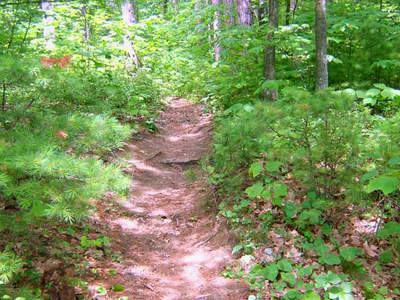
Before setting out on the trail, the investigators write down one question each.
The field team then heads off, led by the navigator, to find the exhibit. They try it out, follow any instructions, see what it's all about.
They take their time. They work out their answer to the first question.
The communicator then uses a mobile phone to text the answer - a few words, often just one - back to the control team.
The field team has a discussion and texts the answer to the second question to the control team.
The control team tries both answers on the computer. If an answer is wrong the control team asks the field team to try again.
Helpful hints are available from the computer, if needed.
Next leg
If the computer accepts the answers it produces the name of the next exhibit and its photograph.
The field team now heads back to become the control team for the next leg of the investigation.
The control team becomes the field team and goes off to search for the next exhibit - after waiting for the field team, in case someone else takes the computer.
Before starting, please take a look at the big question raised by the news story.
Good detecting
News: Thumbs up to Einstein
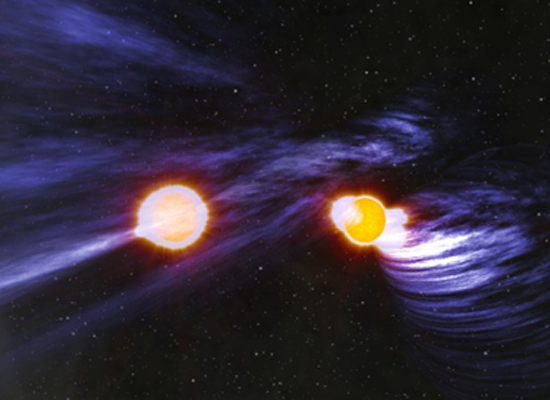
The latest news is about two strange stars in orbit around each other, way out in space.
It's about what these tell us about general relativity, the best theory we have about space, time and matter.
Albert Einstein devised the theory of relativity almost a hundred years ago.
He came here to Glasgow some time later and told an audience at Glasgow University all about it.
Through the big window on your left you can see Glasgow University on the skyline, looking like this:
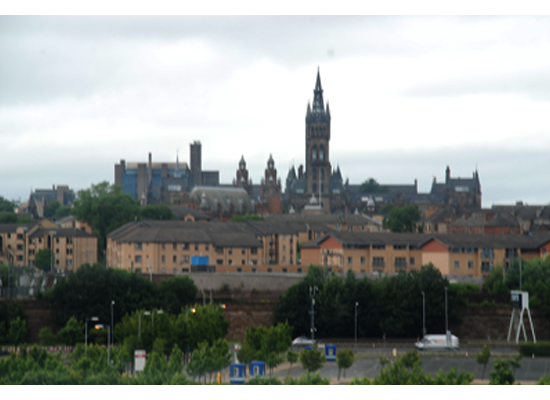
Bute Hall, where Einstein gave his lecture, is in the building behind that tall spire.
The big question
Relativity has so far passed every test thrown at it.
So here is your big question:
What is the theory of relativity all about?
Are you ready to go looking for clues?
Here's the name of the first exhibit you should try to find, and a couple of photographs to show you what it looks like:
Plummeting plumage
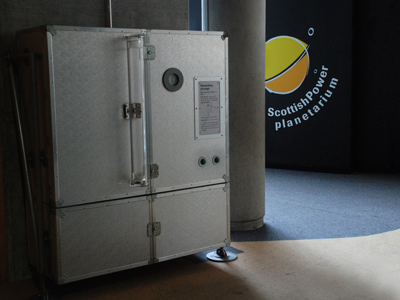
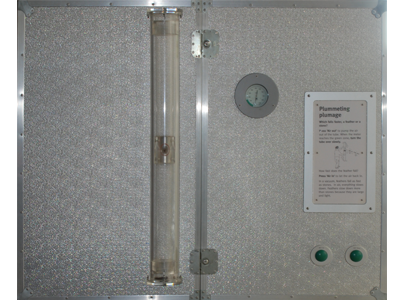
Once you've found this exhibit, have a play with it. Follow the instructions with the air in and especially with the air out.
Here are your questions for this exhibit:
1. When the air is out of the tube, is the result of this experiment a big surprise to the members of your team?
2. Now fill in the blank in this sentence: When there is no air to slow things down, everything _ _ _ _ _ towards the ground at the same rate.
(Note: science detectives only get to see the instructions for the next exhibit as each correct word is inserted into the computer. For simplicity of presentation the mechanism for this has not been implemented on this page.)
Sink or float
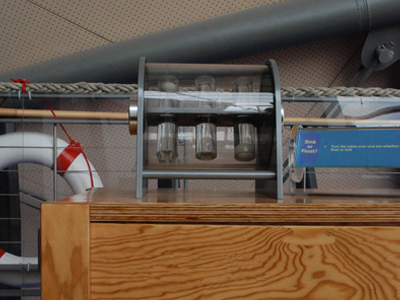
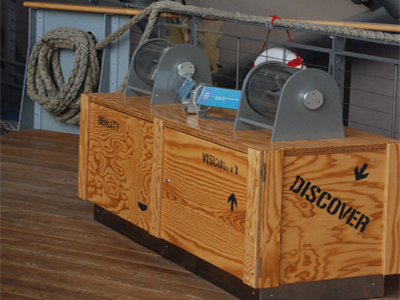
Here are your questions for this exhibit:
1. When you follow the instructions on the twirling triangle, which ball moves the fastest - the left, middle or right?
2. Complete this sentence using a word you will find at the exhibit: Either the balls or the liquids must have different weights for their size. Scientists say they have a different _ _ _ _ _ _ _.
In a spin
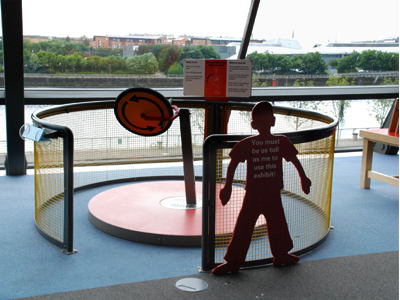
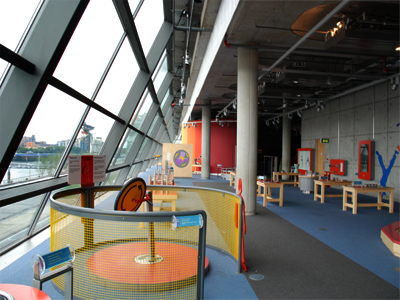
Take your time with this one and make sure everyone gets a turn. There are lots of ways you can move the wheel when it's spinning. But there is a pattern to what happens to the platform that you stand on.
Take turns to move the wheel so that it is spinning clockwise when you look down at it. Then try again with it spinning anti-clockwise.
Here are your two questions:
1. As you look down, in which direction does the platform spin when you make the wheel spin clockwise?
2. Complete this sentence: If a wheel is _ _ _ _ _ _ _ _ really fast it is hard to change its direction.
Points of view
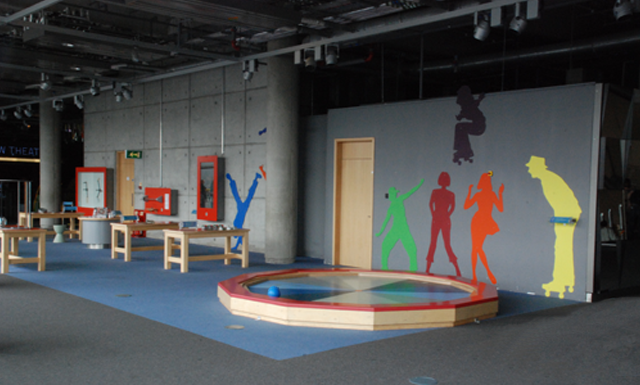
Take turns. Everyone should get a chance to stand on the roundabout and roll the ball from one white spot to the other - and to stand beside the roundabout and watch its path.
Here are your two questions for this exhibit:
1. When you try to roll the ball slowly from one white spot to the other, roughly how far do you miss by?
2. Complete this sentence: When I'm on the roundabout the path of the ball looks curved. But when I'm off the roundabout, and someone else rolls the ball, its path is a _ _ _ _ _ _ _ _ line.
Gravity well

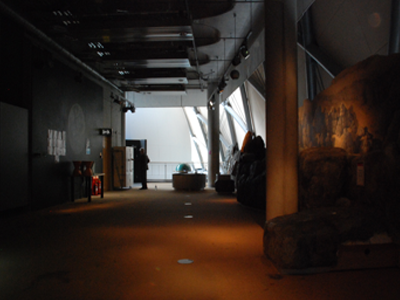
We do something slightly different with this exhibit. We give you a word before you go.
The word is orbit
An orbit is a path that something follows for a very long time. Satellites have orbits around the Earth. The Earth has an orbit round the Sun. The twin pulsars have orbits around each other.
Think about orbits in this exhibit as you take turns to roll the balls.
Have a few practice rolls. If you throw too fast the ball jumps out, too slow and it gets swallowed quickly. You'll soon get the hang of it.
Here are your questions:
1. What is the most number of times anyone in your team can make the ball go completely around?
2. Complete this sentence: The only thing stopping a ball from having an orbit (a path that goes round for a very, very long time) is the force of _ _ _ _ _ _ _ _ between the ball and the black plastic.
Back at the computer
You have now finished this part of the relativity science trail. You have gathered a number of important clues to what the latest news story is about.
Here are all of them: orbit, density, spinning, straight line, everything falls towards the ground at the same rate.
How many did you get?
If you got them all, well done. You are excellent science detectives.
Solving the Puzzle
Do you remember what the big question was? What exactly is relativity all about?
Solving the puzzle helps you to put your science trail clues together to answer this question. Take a look when you've time.
Take a look too at the twin pulsar news story to see how scientists have been testing general relativity, not for the first time.
Try to spot all the places where your science-trail clues appear.
Falling feathers again
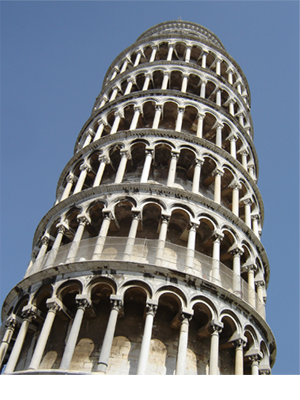
You are going to find the final thing we tell you quite hard to believe.
It doesn't look it, but Plummeting Plumage is the most important experiment on this science trail.
In fact it's the most important experiment at Glasgow Science Centre.
Actually it might be the most important experiment ever, anywhere. In the history of the world.
We've got to be kidding, right?
It's just a big grey box with a plastic tube and stuff.
Surely this is nobody's most important experiment ever?
Well, yes it could be.
Words of wisdom
If you don't believe us, will you believe Albert Einstein?
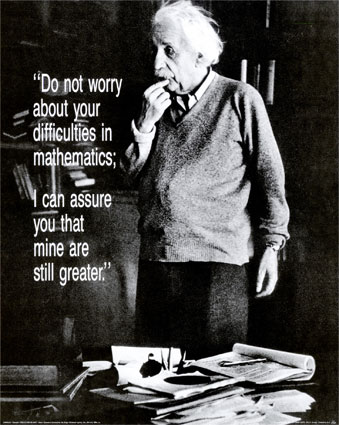
Here's what Einstein told his audience at Glasgow University on 20 June 1933 about the results of the vacuum drop experiment - that everything falls towards the ground at the same rate:
"I wondered how this law could exist and believed that it held the key of the understanding of inertia and gravitation."
This one experiment made Einstein think deeply about gravity, forces and points of view.
It gave him a whole new way of looking at space and time.
It led him to general relativity.
You can learn how, see the way your science trail clues fit together and hear a few more words from Albert Einstein when he came to Glasgow University by taking a look at Solving the Puzzle.
End of the trail?
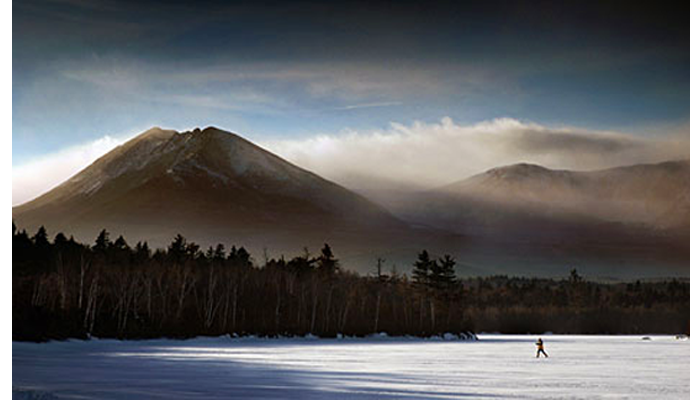
So where do you go from here? Does the science trail end at Glasgow Science Centre?
It doesn't have to.
Some of you will become scientists one day. Perhaps you will devise a new theory of space, time and matter - and maybe even falling feathers.
So what exactly is a scientist?
One answer is that it's someone who has been to university to study physics, chemistry, biology or astronomy, and now does science for a living.
A simpler answer is this:
A scientist is someone who asks questions and keeps on looking for answers.
Do you remember this?
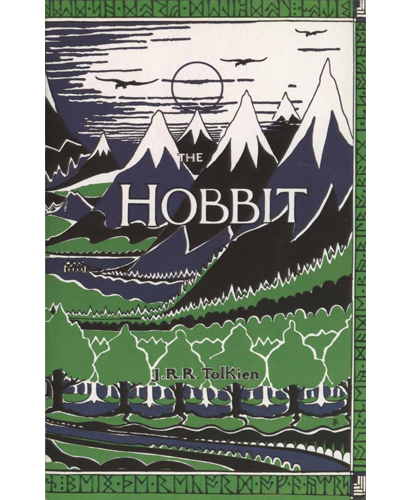
Roads go ever ever on,
Over rock and under tree,
By caves where never sun has shone,
By streams that never find the sea;
Over snow by winter sown,
And through the merry flowers of June,
Over grass and over stone,
And under mountains of the moon.


